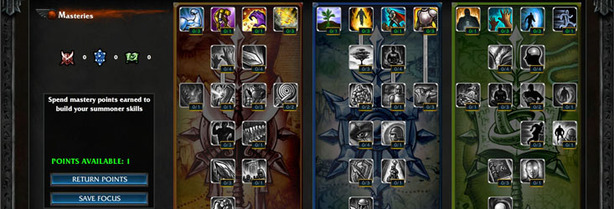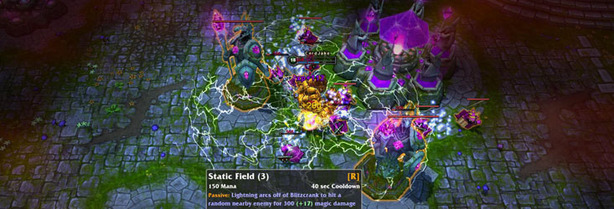
We Are The Champions
What makes League of Legends so addictive to some is that even though it’s a fairly simple game to get your head around, it’s actually deceptively difficult and players are constantly having to track a number of different events.Revenue is perhaps the most obvious meter in the game and League of Legends uses an odd system where you get a bounty for every killing blow you land, while also having gold constantly accrue in your coffers every second your champion is alive – though not in the 30 seconds it takes for your champion to respawn back at your base.
The fact that it’s the killing blow which decides whether or not you get the money is interesting as it encourages you to focus on engaging the weakest enemies on the field with your strongest weapons, leaving your minions to soften up the rest of the opponents until you can land fatalities on them.
Your minions aren’t as useless as they first appear even though they’re fairly weak at the start of the game and can’t be controlled at all – each base has an inhibitor that, if destroyed, upgrades all your minions to more powerful variants. The turning point of the match is usually who destroys an enemy inhibitor first, as doing so gives you an immediate and definite advantage over the enemy.
Either way, once you’ve landed enough killing blows and your treasury is suitably opulent you can buy items from the shop to help upgrade your champion. There are plenty of cheap items that are helpful for low level characters, as well as health potions and consumables, but the best gear is always unlocked through combining lesser items. A single red gem might only give your champion +200 Health, but complement it with a blue gem and you might unlock a pendant with whole new passive abilities, like life steal or health regeneration.
The shop itself can be quite difficult to navigate at first because it’s broken down into so many subsections, but League of Legends includes a recommended item list that is helpful for those in a rush or if it’s your first time using a particular hero. One of the especially nice touches is that League will automatically combine your items into upgraded versions if you have the required funds. Being able to quickly buy the Enhanced Boots of Speed is definitely preferable to having to buy the lesser items manually, then complete the recipe.
What helps set LoL apart from other RTS/RPG games though is that there’s an equal amount of planning which goes on before a match as there is that goes on during it. League of Legends has a persistent online component that lets you level up your abilities over time and unlock new champions, spells and runes to help you in future matches.
The use of spells is especially important as players are only able to carry two of them into a match, casting them when needed to help your champion out of a spot of bother. We honestly can’t count the number of times that a hastily applied Ghost spell has increased our movement speed enough to let us get around a particularly troublesome turret, or how often a heal spell has provided the longevity to make that final push against an enemy inhibitor.
Unfortunately though the usefulness of spells and runes isn’t something that’s ever really communicated and while League of Legends claims to be as user-friendly as possible a lot of that is an empty promise. There are plenty of online FAQs and the official forums are very active, but the included documentation is a bit lacking and the tutorial isn’t extensive.
In fact, the tutorial is an especially sore point and utterly fails at introducing any of the more complex areas of the game. It doesn’t highlight the recommended items list in the shop or provide any information about how to navigate the lobbies or online stores, for example. It’s entirely focused on explaining simple concepts like fog of war, while skipping over the more involved issues of using runes or swapping spells.
Granted, that information can be found with a little bit of Google-fu and some time on the official site – but forcing you to look there is contrary to the idea of a tutorial, isn’t it?

MSI MPG Velox 100R Chassis Review
October 14 2021 | 15:04











Want to comment? Please log in.